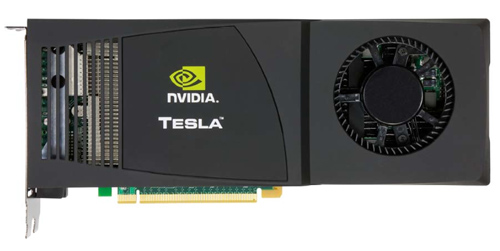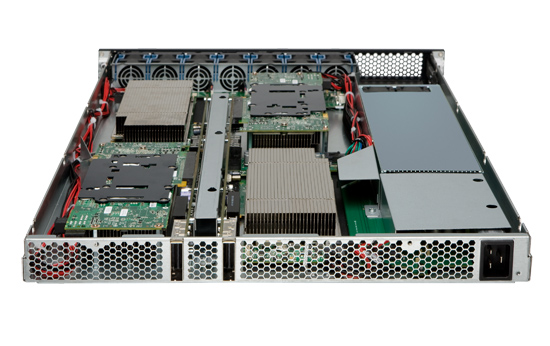NVIDIA's Fermi: Architected for Tesla, 3 Billion Transistors in 2010
by Anand Lal Shimpi on September 30, 2009 12:00 AM EST- Posted in
- GPUs
A Different Sort of Launch
Fermi will support DirectX 11 and NVIDIA believes it'll be faster than the Radeon HD 5870 in 3D games. With 3 billion transistors, it had better be. But that's the extent of what NVIDIA is willing to talk about with regards to Fermi as a gaming GPU. Sorry folks, today's launch is targeted entirely at Tesla.

A GeForce GTX 280 with 4GB of memory is the foundation for the Tesla C1060 cards
Tesla is NVIDIA's High Performance Computing (HPC) business. NVIDIA takes its consumer GPUs, equips them with a ton of memory, and sells them in personal or datacenter supercomputers called Tesla supercomputers or computing clusters. If you have an application that can run well on a GPU, the upside is tremendous.

Four of those C1060 cards in a 1U chassis make the Tesla S1070. PCIe connects the S1070 to the host server.
NVIDIA loves to cite examples of where algorithms ported to GPUs work so much better than CPUs. One such example is a seismic processing application that HESS found ran very well on NVIDIA GPUs. It migrated a cluster of 2000 servers to 32 Tesla S1070s, bringing total costs down from $8M to $400K, and total power from 1200kW down to 45kW.
| HESS Seismic Processing Example | Tesla | CPU |
| Performance | 1 | 1 |
| # of Machines | 32 Tesla S1070s | 2000 x86 servers |
| Total Cost | ~$400K | ~$8M |
| Total Power | 45kW | 1200kW |
Obviously this doesn't include the servers needed to drive the Teslas, but presumably that's not a significant cost. Either way the potential is there, it's just a matter of how many similar applications exist in the world.
According to NVIDIA, there are many more cases like this in the market. The table below shows what NVIDIA believes is the total available market in the next 18 months for these various HPC segments:
| Processor | Seismic | Supercomputing | Universities | Defence | Finance |
| GPU TAM | $300M | $200M | $150M | $250M | $230M |
These figures were calculated by looking at the algorithms used in each segment, the number of Hess-like Tesla installations that can be done, and the current budget for non-GPU based computing in those markets. If NVIDIA met its goals here, the Tesla business could be bigger than the GeForce one. There's just one problem:
As you'll soon see, many of the architectural features of Fermi are targeted specifically for Tesla markets. The same could be said about GT200, albeit to a lesser degree. Yet Tesla accounted for less than 1.3% of NVIDIA's total revenue last quarter.
Given these numbers it looks like NVIDIA is building GPUs for a world that doesn't exist. NVIDIA doesn't agree.
The Evolution of GPU Computing
When matched with the right algorithms and programming efforts, GPU computing can provide some real speedups. Much of Fermi's architecture is designed to improve performance in these HPC and other GPU compute applications.
Ever since G80, NVIDIA has been on this path to bring GPU computing to reality. I rarely get the opportunity to get a non-marketing answer out of NVIDIA, but in talking to Jonah Alben (VP of GPU Engineering) I had an unusually frank discussion.
From the outside, G80 looks to be a GPU architected for compute. Internally, NVIDIA viewed it as an opportunistic way to enable more general purpose computing on its GPUs. The transition to a unified shader architecture gave NVIDIA the chance to, relatively easily, turn G80 into more than just a GPU. NVIDIA viewed GPU computing as a future strength for the company, so G80 led a dual life. Awesome graphics chip by day, the foundation for CUDA by night.
Remember that G80 was hashed out back in 2002 - 2003. NVIDIA had some ideas of where it wanted to take GPU computing, but it wasn't until G80 hit that customers started providing feedback that ultimately shaped the way GT200 and Fermi turned out.
One key example was support for double precision floating point. The feature wasn't added until GT200 and even then, it was only added based on computing customer feedback from G80. Fermi kicks double precision performance up another notch as it now executes FP64 ops at half of its FP32 rate (more on this later).
While G80 and GT200 were still primarily graphics chips, NVIDIA views Fermi as a processor that makes compute just as serious as graphics. NVIDIA believes it's on a different course, at least for the short term, than AMD. And you'll see this in many of the architectural features of Fermi.










415 Comments
View All Comments
silverblue - Thursday, October 1, 2009 - link
Anand's entitled to make mistakes. You do nothing else.SiliconDoc - Thursday, October 1, 2009 - link
Oh golly, another lie.First you admit I'm correct, FINALLY, then you claim only mistakes from me.
You're a liar again.
However, I congratulate you, for FINALLY having the half baked dishonesty under enough control that you offer an excuse for Anand.
That certainly is progress.
silverblue - Friday, October 2, 2009 - link
And you conveniently forget the title of this article which clearly states 2010.johnsonx - Wednesday, September 30, 2009 - link
I think there might be something wrong with SiliconDoc. Something wrong in the head.SiliconDoc - Thursday, October 1, 2009 - link
I think that pat fancy can now fairly be declared the quacking idiot group collective's complete defense.Congratulations, you're all such a pile of ignorant sheep, you'll swather together the same old feckless riddle for eachothers emotional comfort, and so far to here, nearly only monkeypaw tried to address the launch lie pointed out.
I suppose a general rule, you love your mass hysterical delusionary appeasement, in leiu of an actual admittance, understanding, or mere rebuttal to the author's false launch accusation in the article, the warped and biased comparisons pointed out, and the calculations required to reveal the various cover-ups I already commented on.
Good for you people, when the exposure of bias and lies is too great to even attempt to negate, it's great to be a swaddling jerkoff in union.
I certainly don't have to wonder anymore.
Griswold - Wednesday, September 30, 2009 - link
So, you're the new village fool?Finally - Thursday, October 1, 2009 - link
Make that "Global Village Fool 2.0"He is an advanced version, y'know?
SiliconDoc - Wednesday, September 30, 2009 - link
Nvidia LAUNCHED TODAY... se page two by your insane master Anand.--
YOU'VE all got the same disease.
MonkeyPaw - Wednesday, September 30, 2009 - link
Is sanity now considered to be a disease? We're not the one's visiting a website in which we so aggressively scream "bias" on (apparently) every GPU article. If you think Anand's work is so offensive and wrong, then why do you keep coming back for more?Anyway, I just don't see where you get this "bias" talk. For crying out loud, you can't make many assumptions about the product's performance when you don't even know the clock speeds. You can guess till you're blue in the face, but that still leaves you with no FACTS. Also keep in mind that GT300 will have ECC enabled (at least in Tesla), which has been known to affect latency and clock speeds in other realms. I'm not 100% sure how the ECC spec works in GDDR5, but usually ECC comes at a cost.
As for "paper launch," ultimately semantics don't matter. However, a paper launch is generally defined as a product announcement that you cannot buy yet. It's frequently used as a business tactic to keep people from buying your competitor's products. If the card is officially announced (and it hasn't), but no product is available, then by my definition, it is a paper launch. However, everyone has their own definition of the term. This article I see more as a technology preview, though nVidia's intent is still probably to keep people from buying an RV870 right now. That's where the line blurs.
SiliconDoc - Thursday, October 1, 2009 - link
A launch date is the date the company claims PRODUCT WILL BE AVAILABLE IN RETAIL CHANNELS.No "semantics" you whine about or cocka doodle do up will change that.
A LAUNCH date officially as has been for YEARS sonny paw, is when the corp says "YOU CAN BUY THIS" as a private end consumer.
---
Anything ELSE is a showcase, an announcement, a preview of upcoming tech, a marketing plan, ETC.
---
YOU LTING ABOUT THE VERY ABSOLUTE FACTS THAT FOR YEARS HAVE APPLIED PERIOD IS JUST ANOTHER RED ROOSTER NOTCH ACQUIRED.